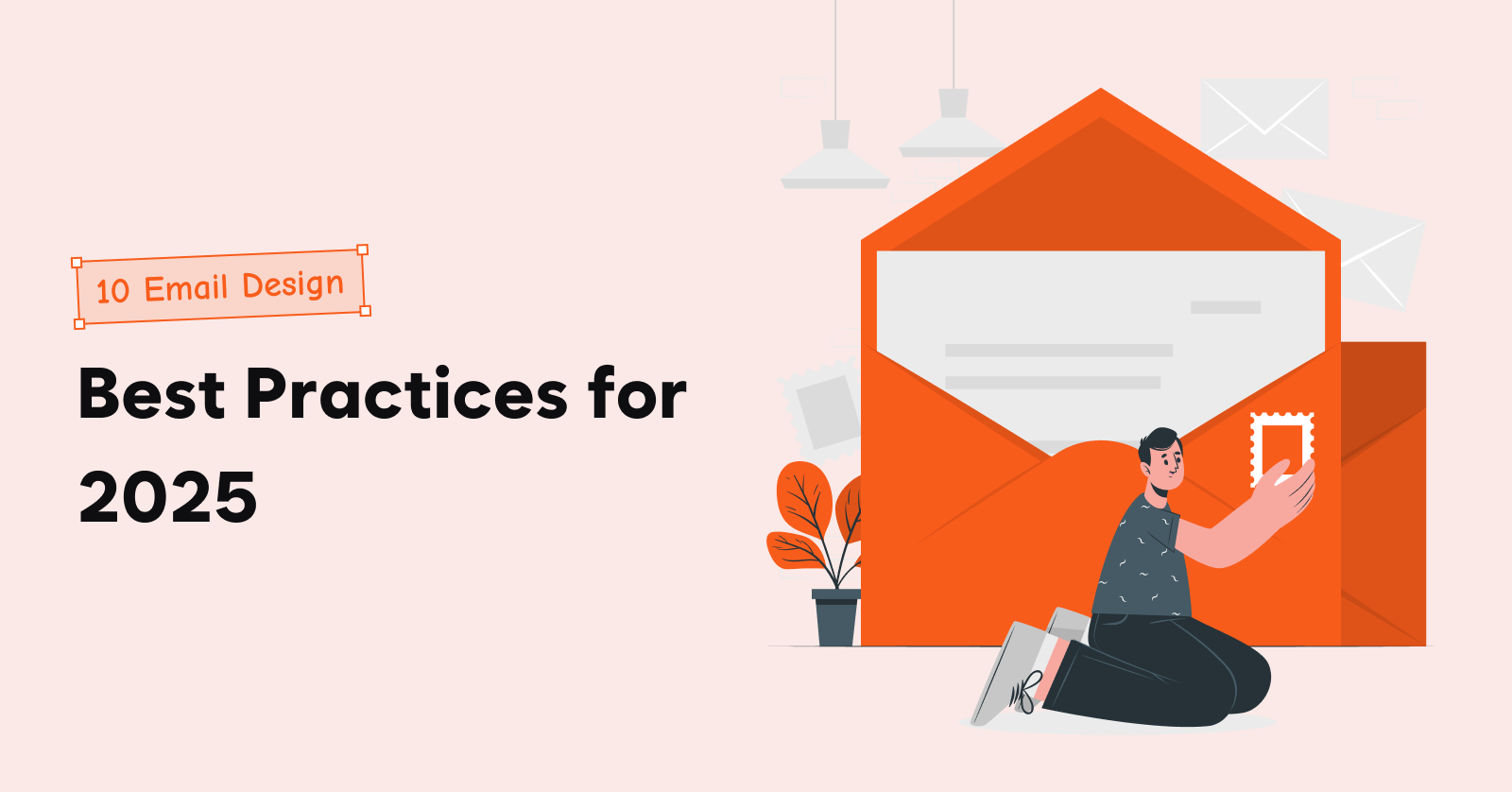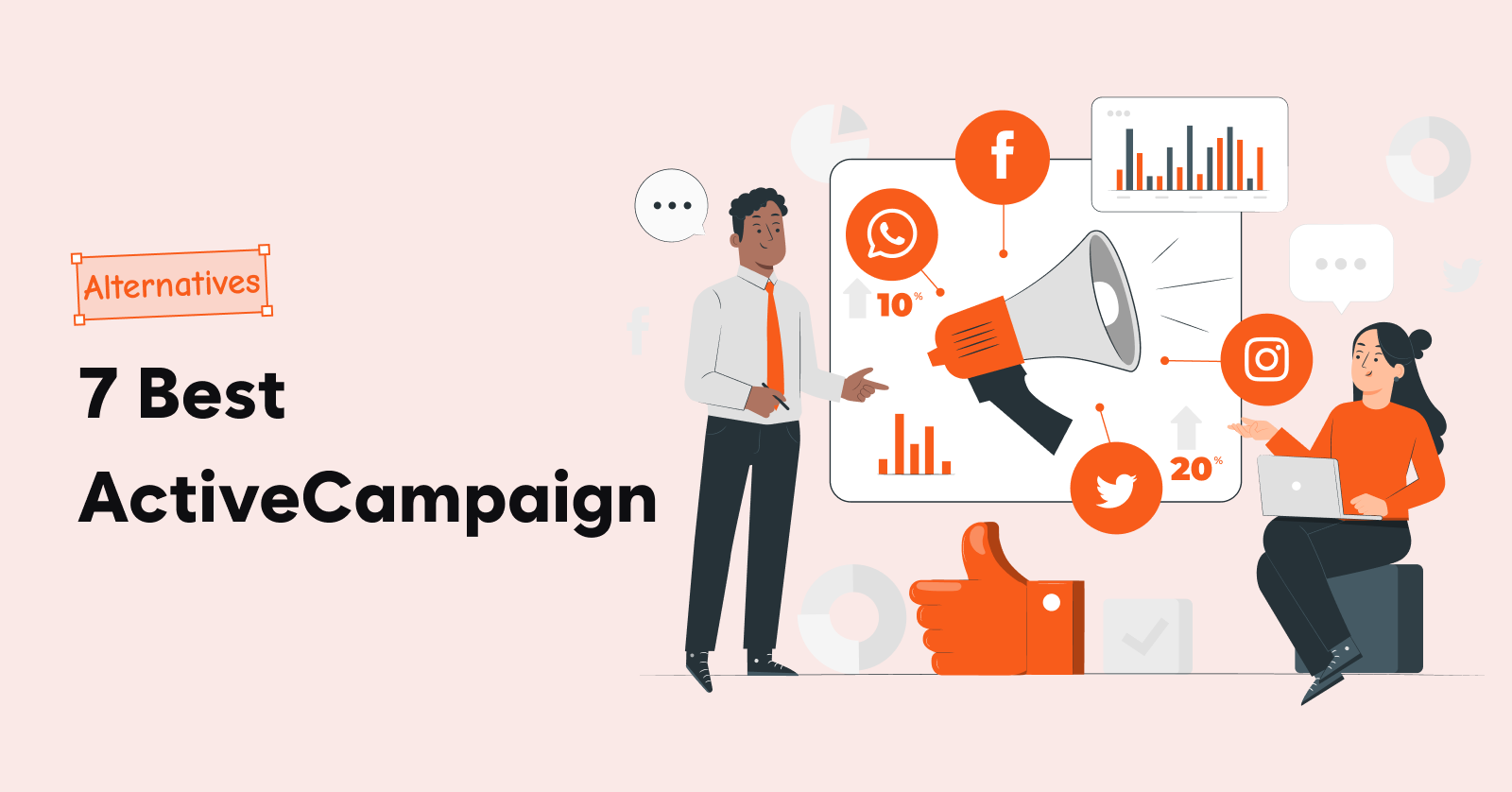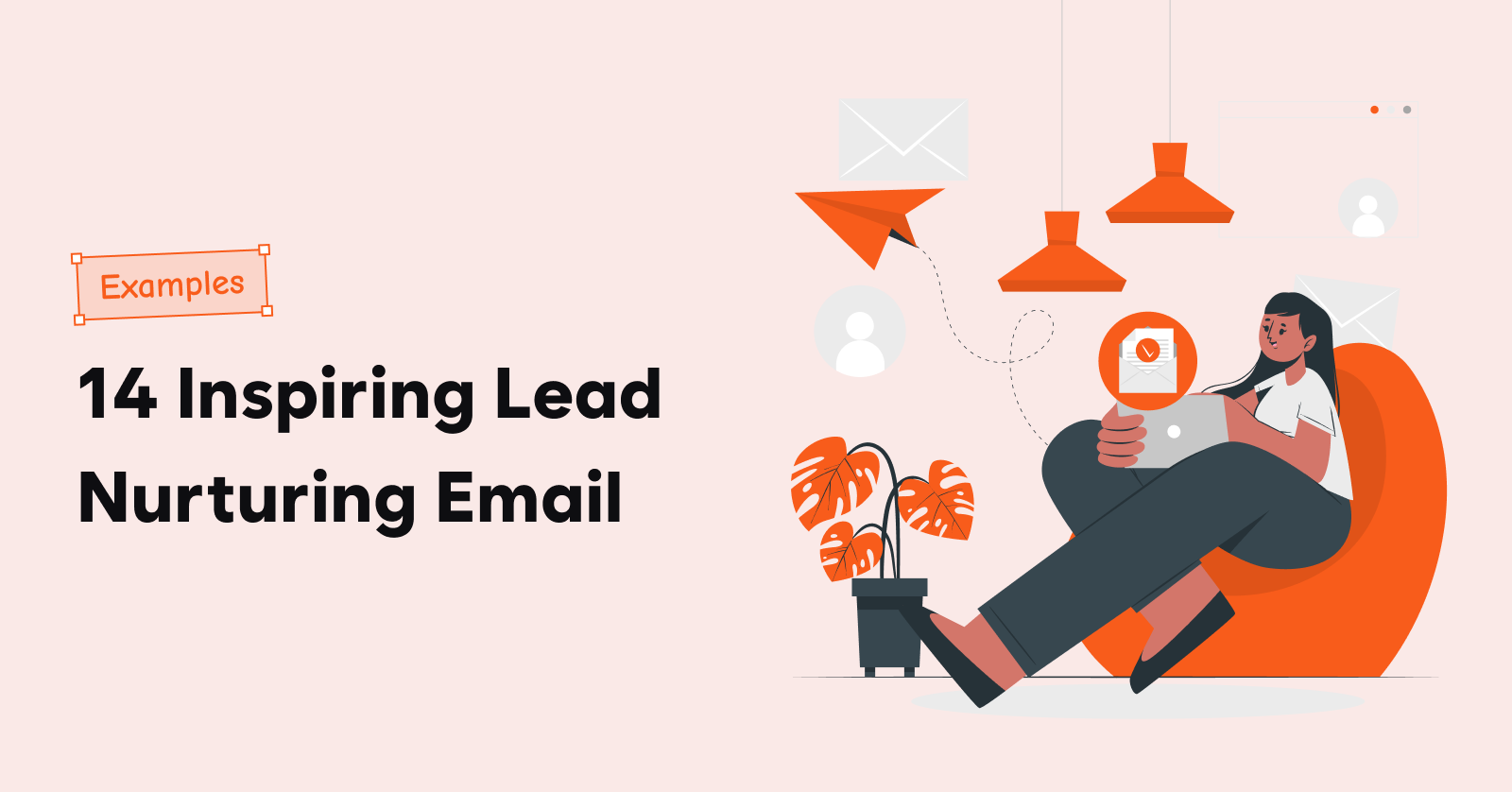Designing the perfect ecommerce email templates isn’t just about slapping together a few product images and a catchy headline.
It is about writing an ecommerce email campaign copy that speaks to the needs and desires of your customers. These best ecommerce email marketing template examples we listed nail at doing that.
In this blog, we explain:
- Email marketing funnel and types of ecommerce email campaigns to send
- 11 best ecommerce email templates
- How to increase the CTR of your ecommerce email template design?
Send ecommerce emails in minutes with Retainful’s ready-made template library.
Email Marketing Funnel and Types of Ecommerce Emails
Which stage a customer occupies in your email marketing funnel directly influences the type of ecommerce email campaign you send.
Think of it as speaking the right language at the right time – each stage demands a different approach to keep the conversation going and nudge them forward.
The best ecommerce email marketing strategy is to send emails that customers in each stage of the funnel resonate with.
Here are the stages of ecommerce email funnel and ecommerce email examples to send:
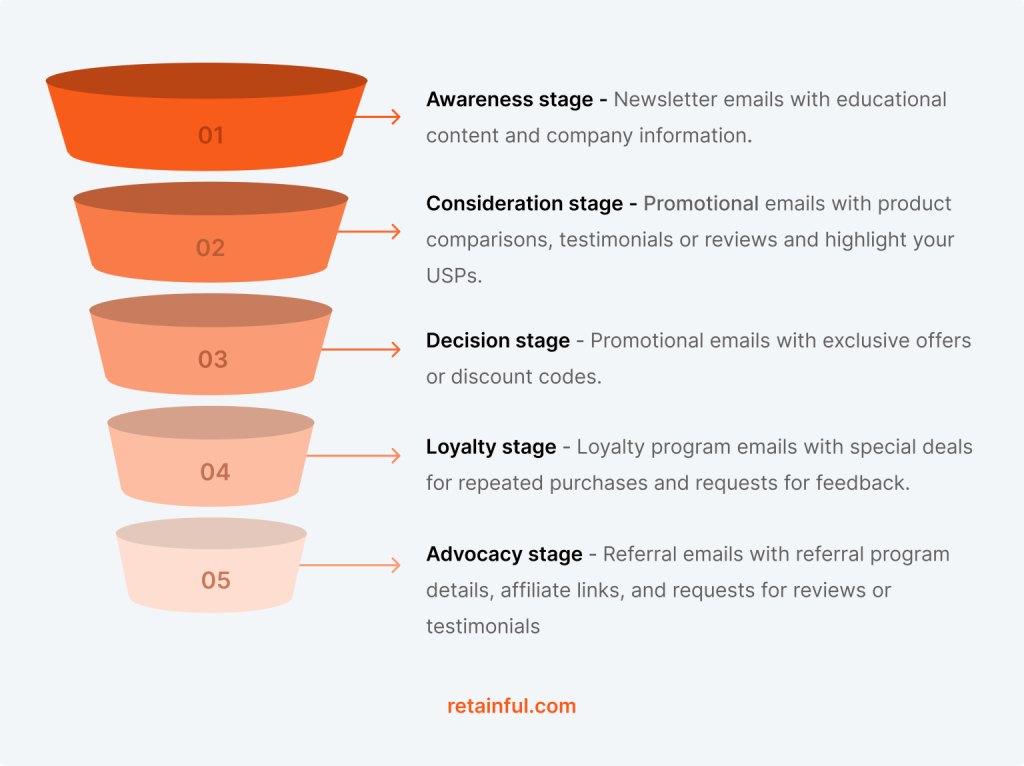
1. Top-of-the-funnel ecommerce email examples
Let people know who you are and why you exist. Showcase what your brand stands for – benefits and a quick brand story.
Type of ecommerce emails to send in this stage:
- Welcome email series
- Educational content
- Email newsletters
2. Middle-of-the-funnel ecommerce email examples
Help them compare, explore, and see the real value. Dive deeper into features, share success stories, or highlight what makes you unique.
Type of ecommerce emails to send in this stage:
- Case studies and testimonials
- Deep-dive guides
- Comparison emails
3. Bottom-of-the-funnel ecommerce email examples
Give them a reason to buy now and often. Focus on urgency, clear CTAs, and compelling incentives (discounts, free shipping, or bonuses).
Type of ecommerce emails to send in this stage:
- Promotional emails
- Special offers and discounts
- Referral emails
- Loyalty program emails
11 Best Ecommerce Email Templates
- Order confirmation email template
- Ecommerce welcome email template
- Feedback request email template
- Ecommerce abandoned cart email template
- Thank you email template
- Email newsletter template
- Back-in-stock email template
- Product recommendation email template
- Upsell/cross-sell email template
- Ecommerce promotional email template
- Win-back email template
Let’s pick apart these best ecommerce email templates in detail.
1. Ecommerce order confirmation email template
When to send: Right after the completion of the purchase.
Right after a purchase, customers need reassurance.
Without an order confirmation email, doubts creep in. Did they get the right item? Will it arrive on time? A clear, concise ecommerce order email answers these questions upfront.
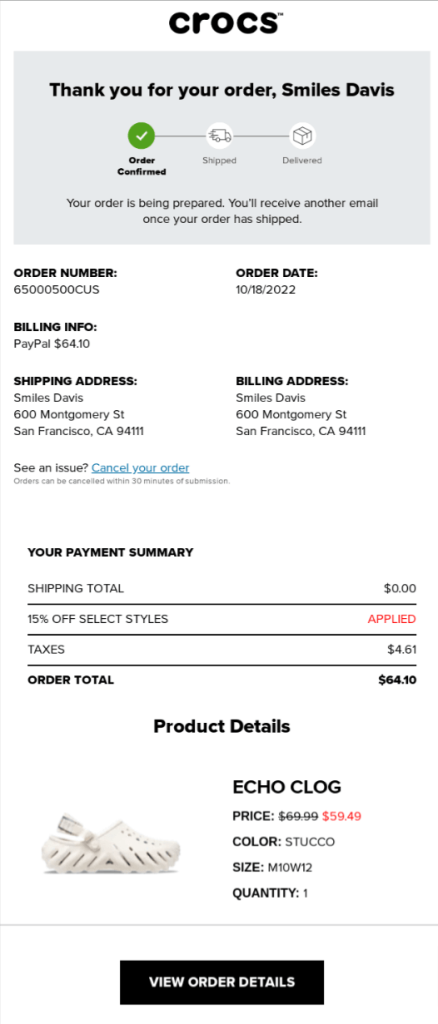
Why is this the best ecommerce order email template?
The heart of this order follow-up email template lies in its comprehensive order summary. The ordered items are listed with high-quality images, clear descriptions, quantities, and prices.
Post-purchase uncertainty is natural, and this ecommerce email campaign template addresses it head-on with reassuring language like “We’re processing your order” or “Your satisfaction is our priority.”
The most effective element in this post-purchase ecommerce marketing email example is the prominent order status indicator with the checkmark icon. This visual cue immediately reassures the recipient that their order has been successfully placed.
The “Cancel Your Order” option is discreetly placed, providing flexibility for customers who may need to cancel their order within the specified timeframe.
2. Ecommerce welcome email template
When to send: Immediately after someone subscribes to your email
Welcome emails generate 320% more revenue on a per-email basis than other promotional emails. That’s why it is one of the most important ecommerce emails one can send in email marketing.
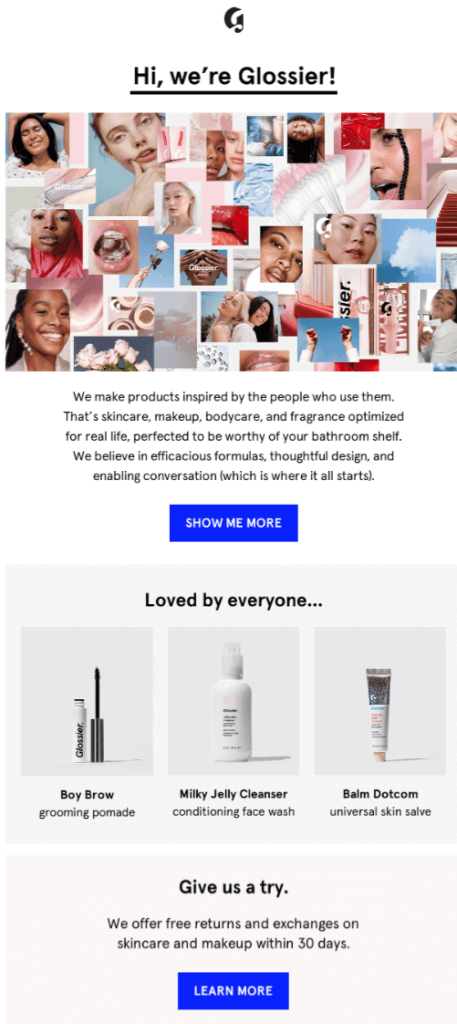
Why is this the best ecommerce welcome email template?
People don’t just buy what you do; they buy why you do it.
This ecommerce welcome email template doesn’t sell products – it sells belief. It invites readers into a movement that’s bigger than beauty. It’s emotional marketing at its finest.
Including about return policy eliminates the biggest barrier to buying online: fear of regret.
The CTA is bold, simple, and action-oriented. The CTA best practice is to direct the user to explore more products in the CTA.
For newcomers, navigating a brand’s entire product range can be overwhelming. Featuring best sellers acts as a curated introduction, this best ecommerce email template guides new customers toward the products that define your brand’s identity and value proposition.
3. Ecommerce feedback request email template
When to send: 5-7 days after the purchased product is delivered.
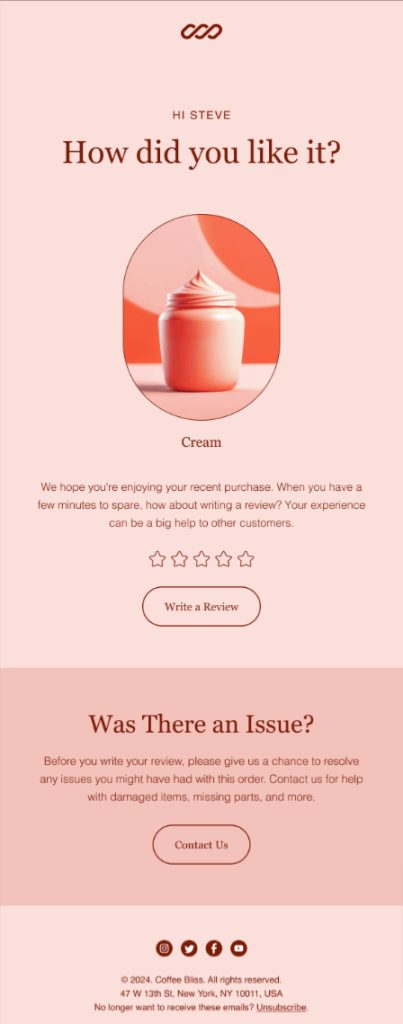
Why is this the best ecommerce feedback request email template?
Clarity and brevity are your best friends in email marketing. This best ecommerce email marketing template tells you everything you need to know without a single wasted word.
The text “Share Your Thoughts” paired with a straightforward explanation of why the feedback is needed makes the request clear and direct. It respects the reader’s time, which is crucial in ecommerce email marketing.
4. Ecommerce abandoned cart email template
When to send: 1-2 hours after cart abandonment
Abandoned cart emails have proved to be the best abandoned cart recovery method in e-commerce email marketing. An abandoned cart email campaign can recover up to 15-20% of lost sales.
The best times to send abandoned cart email series are:
- Email 1: The Initial Reminder (After 1-3 hours of cart abandonment)
- Email 2: Offer an incentive (After 24 hours of cart abandonment).
- Email 3: Add a sense of urgency (After 48 hours of abandonment).
- Email 4: Social proof (After 3 days of cart abandonment)
- Email 5: The last chance to grab the offer (After 5-7 days of cart abandonment)

Why is this the best ecommerce abandoned cart email template?
Addressing affordability is a huge conversion driver, especially for premium products like Sonos speakers.
Most ecommerce brands don’t think about customer support in abandoned cart emails. But here’s the thing: hesitation often comes from unanswered questions. By offering proactive support, this best ecommerce email marketing template says, “We’re here to help you decide, no pressure.”
The best elements are the customer objection handling ones like:
- Shop now, pay later
- Generous return policy
- Making customer support accessible
- Free shipping
These elements in this ecommerce email template address the risks and reassure the customer your product and delivery experience will match their expectations.
Here is a free ecommerce cart abandonment email template for you to use in Retainful:
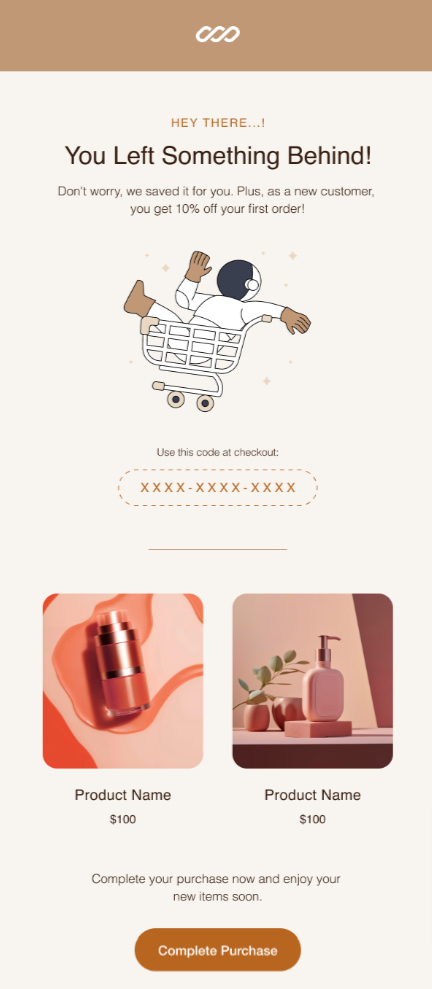
Related Reading: Learn how to send abandoned cart emails in your ecommerce store:
- How to send WooCommerce abandoned cart emails? A step-by-step guide
- Shopify Abandoned Cart Email – Strategies and Templates to Recover Lost Sales
5. Ecommerce thank you email example
When to send: After someone sign-up for your email list or after a first purchase.
A simple thank you email goes a long way in providing a positive post-purchase experience to the customers. A positive one ensures that the customers will come back for more, driving repeat purchases.
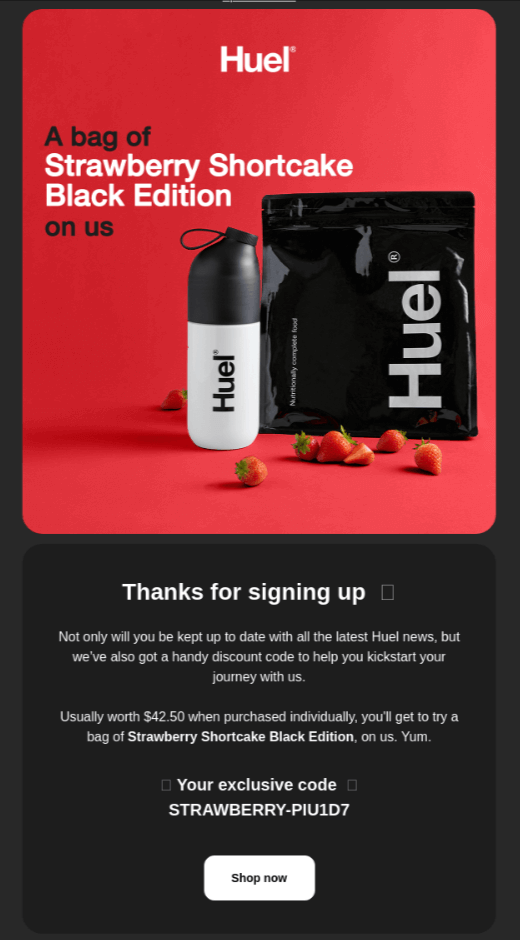
Why is this the best ecommerce thank-you email template?
Customers don’t just want free stuff – they want valuable free stuff. By emphasizing the price tag of the free item, this best email marketing template for ecommerce elevates the perceived value of the offer.
This best ecommerce email marketing template also doesn’t waste time with fluff. They lead with the reward, which happens to be a premium product worth $42.50 – a detail that’s repeated later to hammer home the value.
The ecommerce email template design is conversational and welcoming. It doesn’t feel salesy or corporate. Instead, it’s written as if a friend is giving you a heads-up about something cool.
6. Ecommerce newsletter template
When to send: 3 days after customer purchases the product or as part of the nurturing email sequence.
Sending ecommerce product education newsletter email template does two things:
- Ensures that customers extract maximum value from their purchases,
- Helps customers understand the features, benefits, and unique selling points of your products.

Why is this the best ecommerce newsletter email template?
In this best ecommerce email newsletter template, each tip is concise and actionable, broken down into simple do’s and don’ts that anyone can follow. This makes the advice accessible, making sure the customer will remember and act on it.
Brand values matter. In a few icons, this ecommerce email marketing example communicates a lot about its identity and what it stands for, which can be just as important as the quality of the product itself.
Tone can make or break your communication. Here, Dossier uses a tone that’s aligned with how they want the brand to be perceived: expert yet accessible.
Related Reading: Learn all about how to send email drip campaigns to drive repeat sales: Email Drip Campaign: How to Create + Best Practices.
7. Ecommerce back-in-stock email template
When to send: When a product has been checked or previously purchased is back in stock
Back in stock emails see more than a 25% conversion rate, which is exceptionally high, highlighting how effective they are at capturing sales that would otherwise be lost.

Why is this the best ecommerce back-in-stock email template?
“They sold out once before. Just sayin’.” – this line in this ecommerce email marketing template reminds customers that this product isn’t just back – it’s in demand and could potentially sell out again. This can trigger quick action from buyers who might fear missing out again.
The image is the ultimate masterclass in “Show, don’t tell”.
Displaying various color options gives customers the freedom to choose according to their preference directly from the email, which can increase the likelihood of a click-through and a purchase.
8. Ecommerce product recommendation email template
When to send: Right after a purchase or cart abandonment or occasionally to a high-engaged customers
Personalized product recommendations are based on the customer’s past behavior, preferences, and purchase history.
It’s like helping them find treasures they didn’t know they were looking for.
Product recommendations can be a mix of:
- Upsells (higher-priced items than what the customer previously bought)
- Cross-sells (related or complementary items)
This email marketing strategy can significantly increase the average order value.
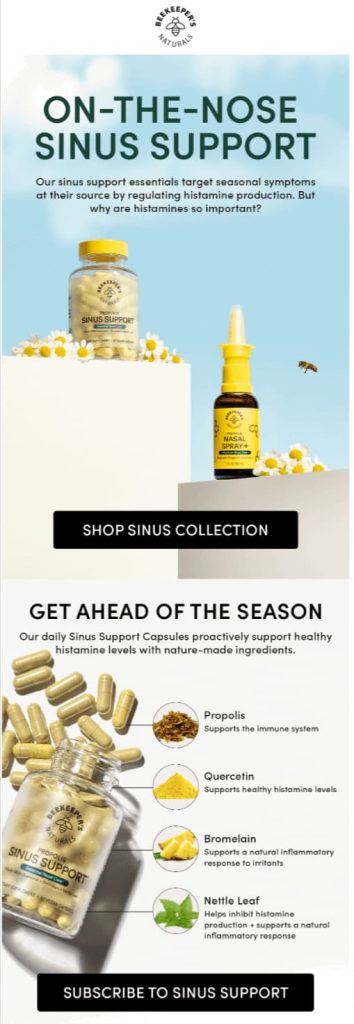
Why is this the best ecommerce product-recommendation email template?
This best ecommerce email template example provides a clear, concise explanation of the product benefits. It’s not just selling a product; it’s offering a solution to a problem, which is far more compelling.
Each ingredient in the product is accompanied by a short explanation of its benefits. This not only educates the consumer about what they’re buying but also reinforces the value of the product through its ingredients.
Every email doesn’t have to end at purchase. The CTA for subscription in this best ecommerce email template ensures ongoing interaction with the customer, providing them with continuous value and increasing brand loyalty.
9. Upsell/cross-sell email example
Acquiring new customers is five times more expensive than selling to an existing one.
So, why not sell more to the existing customers?
Ecommerce upsell and cross-sell emails target customers who have already expressed interest in your products and bag you repeat sales.

Why is this the best ecommerce upsell/cross-sell email example?
“TOSS MORE IN? Add before we ship” – this section of this best ecommerce email template cleverly invites the customer to consider adding more items to their order before it ships.
Relevance is key in cross-selling. By choosing products that logically complement the primary purchase, this best ecommerce email example increases the likelihood of additional sales.
It’s about making the customer’s life easier and their experience better.
The section at the bottom acts as a secondary call to action, encouraging further engagement with the store’s broader product line. It subtly shifts from direct sales tactics to broader brand engagement.
10. Promotional ecommerce email template
When to send: During major sales events or holidays like Labor Day, Black Friday, or Christmas.

Why is this the best ecommerce promotional email template?
The tagline immediately communicates a clear, valuable offer. It’s concise and lets the recipient know exactly what to expect.
The phrase “Stay hydrated all long weekend long!” in this ecommerce promotional email template speaks to the seasonality of the offer, adding relevance and urgency to the promotion.
Also, the instructions on how to redeem the offer are straightforward.
11. Ecommerce win-back email template
When to send: After customer inactivity of 45-90 days
When the customers become inactive, it doesn’t necessarily mean you should consider them a lost cause.
Reactivating just 10% of your email list’s inactive subscribers with a series of win-back emails can increase revenue by as much as 30%.
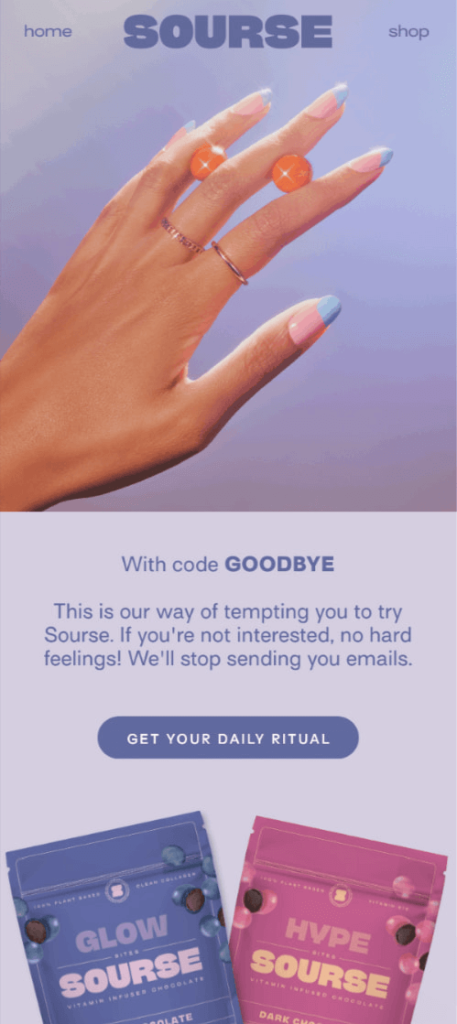
Why is this the best ecommerce win-back email template?
The use of a discount code named “GOODBYE” acts as both a prompt and a potential farewell, which can trigger a sense of loss aversion in customers.
This ecommerce win-back email marketing template clearly states that if the customer is not interested, they can opt out of future communications. This reassures recipients that they have control over their inbox.
A good CTA turns a decision into action. This one isn’t just about purchasing; it states the value the customer will get in return.
Skip the design work of your ecommerce emails with Retainful’s read-made templated and drag-and-drop email editor.
How to increase CTR of ecommerce email template design?
1. Segment your email list and personalize your ecommerce emails
Personalized ecommerce email templates had 100.95% clicks compared to non-segmented emails.
Different customers have different needs and interests.
The best ecommerce email marketing strategy is to segment your email list and send targeted ecommerce email campaigns that are relevant to each group.
Personalized emails are not only about mentioning the customer’s name in the email. They go much beyond that.
For example, here’s what to send in ecommerce email templates you are planning to send for your high-value VIP customers and low-value ones.
What to send your high-value customers:
Reward them with exclusive offers, VIP access to product launches, loyalty program invitations, personalized thank-you notes, and more.
What to send your low-value customers:
Encourage more purchases with upselling and cross-selling, limited-time offers, request feedback, and more.
2. Create a responsive ecommerce email template design
A well-designed ecommerce email template not only catches the eye but also makes the content easy to digest and the call-to-action (CTA) buttons easy to find and click.
Here are some tips to design responsive ecommerce email templates:
- Establish a clear visual hierarchy
- Consistent branding in every email you send
- Include high-quality images of your products
- Include ample white space
3. Include strong CTAs
Instead of a vague “Click Here,” use action-oriented language like “Grab Yours Now” or “Start Saving Today.” Make it feel urgent and exclusive, adding a time limit like, “Offer ends in 24 hours!”
4. Write engaging ecommerce email copy
Customers are more interested in how a product can solve their problems. So give benefits a priority over features.
Use PAS (Problem, Agitate, Solution) ecommerce email copywriting technique:
- Problem: Identify your customer’s pain point
- Agitate: Amplify the problem
- Solution: Present your product as the answer
To make your solution even more compelling, support your claims with social proof, such as customer testimonials, user reviews, or expert endorsements.
5. Include objection handling elements
When customers shop online, their concerns typically stem from one core issue: a lack of certainty.
They worry about the quality of the product, whether the return policy is fair, and how long shipping will take. The more of these doubts you resolve for them, the simpler and faster they can decide to buy.
You can either craft ecommerce email templates specifically designed to address customer concerns, or simply adapt your existing ecommerce marketing emails to tackle objections directly.
6. Ensure high email deliverability
Staying out of spam folders and getting your ecommerce emails opened starts with strong email deliverability practices.
Here’s how to beat the odds of landing in customers’ spam folder:
- Verify your sending domain
- Maintain a clean email list – Routinely delete bounced emails or inactive subscribers.
- Use double opt-In
- Avoid spam trigger words like “Free!” “Act Now!” “Buy Direct!”
Automated ecommerce emails doesn’t have to be lifeless. Personalize within clicks in Retainful.
Start designing converting ecommerce email marketing templates
Ecommerce emails are how you connect, convert, and keep your customers coming back.
The best ecommerce email templates don’t happen by accident. They’re built on best practices: personalization, clear CTAs, clean design, and a message that speaks directly to your customer’s needs.
Follow these ecommerce email marketing template strategies and write emails that speak to the customer at the right time with the right message.
Also read:
- 8 Best Email Automation Software Comparison (2025)
- Shopify Email Marketing: A Guide to Create Email Campaigns
- WooCommerce Email Marketing: An Ultimate Beginner’s Guide
- 10 Best Email Marketing Examples for 2025
Frequently Asked Questions
An ecommerce email is a targeted message that online stores send to communicate with customers or prospects. It includes promotions, product updates, transactional information, or brand storytelling.
Keep eCommerce emails concise, typically between 50 and 150 words. Provide enough information to spark interest and guide recipients toward the desired action.
Optimal send times range from mid-morning to early afternoon, typically 10 AM to 2 PM, when people check emails after starting their day.
Begin with a captivating subject line, followed by concise, value-focused content. Highlight benefits, include strong visuals, and feature a clear call-to-action.
Use an email automation software like Retainful to map customer journeys, setting triggers for sign-ups, purchases, or inactivity.
Segment your email list based on customer data like past purchases, browsing behavior, and demographics. Tailor subject lines and content to individual preferences. Use dynamic fields to insert names or recommended items.
